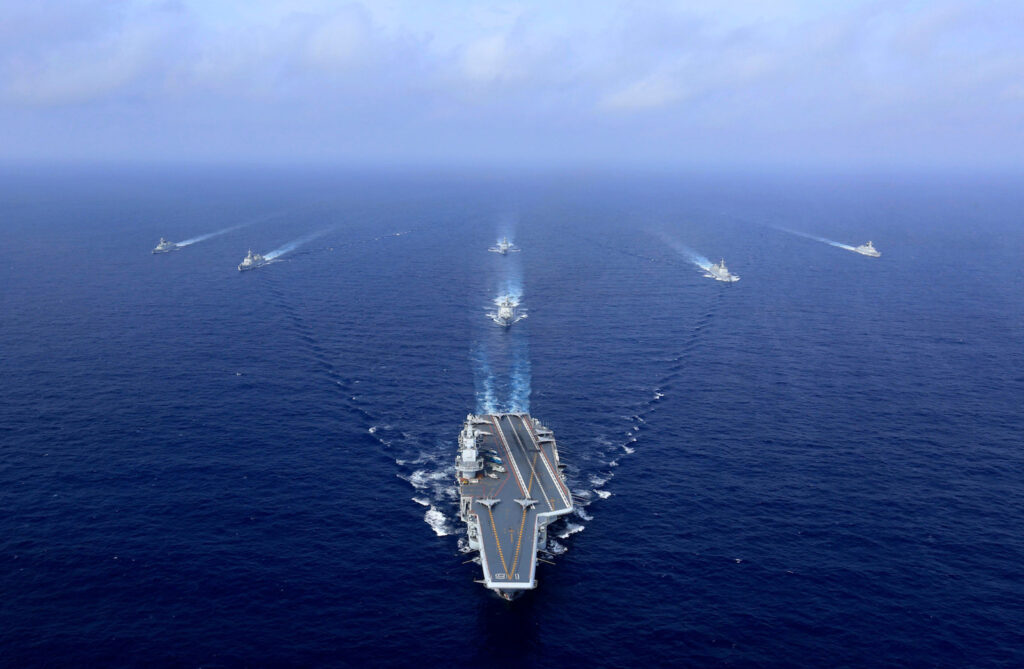Chinese ‘blue force’ engages in naval combat with United States in virtual reality simulation

China is rapidly developing a high-tech “blue force” to simulate US adversaries in combat training, leveraging cutting-edge virtual technologies to sharpen its naval prowess and challenge US dominance in the Pacific.
This month, the US Naval War College published a report on China’s People’s Liberation Army-Navy’s (PLAN) development of a “blue force” for more realistic combat training.
The report says China has been advancing the virtual initiative since the mid-2010s to enhance its naval combat readiness, emulating the operational strategies of Western militaries.
The US Naval War College report reveals that PLAN’s blue force combines manned and unmanned systems, heavily emphasizing virtual simulations and electronic warfare capabilities. It says a synthetic opposition force (OPFOR) simulates potential real-world adversaries, including the US Navy.
Under President Xi Jinping’s directive for more realistic military training, PLAN’s blue force has become increasingly sophisticated in recent years, integrating uncrewed vehicles, simulated electromagnetic environments and advanced training systems, according to the US Naval War College report.
It notes that the PLAN’s blue force was initially makeshift and unprepared, but advancements in virtual technologies and training integration have enhanced the realism and effectiveness of the exercises.
The report says that by building a capable and realistic blue force, PLAN will be able to train more effectively against the US and its allies, improve its combat readiness and potentially undermine the US’ naval dominance and deterrence in the region.
China has been integrating various cutting-edge virtual technologies to simulate realistic combat environments, positioning the PLA to bridge training gaps and prepare for future conflicts.
In a May 2022 Foreign Military Studies Office (FMSO) article, Kevin McCauley says that the PLA is exploring the creation of a “battlefield metaverse” to enhance its training methods and combat capabilities.
According to McCauley, this metaverse aims to simulate future warfare environments using advanced technologies such as virtual reality, AI, quantum technologies, brain-computer interfaces and the Internet of Things (IoT).
He notes that the PLA believes this metaverse can provide troops with immersive, realistic combat experiences, compensating for their lack of actual combat experience.
He says the metaverse allows for testing new tactics and technologies, including the effects of new concept weapons like meteorological weapons and unmanned “blue armies.”
McCauley says this approach is crucial for preparing and winning future military conflicts, as it offers a dynamic and harsh training environment that current so-called “Battle Labs” cannot fully replicate.
Asia Times has noted in multiple reports that China has been using advanced simulations to test cutting-edge military technologies and tactics to prepare for high-intensity conflict scenarios against the US, including a conflict scenario over Taiwan.
In May 2023, Asia Times reported that North University of China researchers conducted a war game simulation demonstrating the effectiveness of China’s hypersonic missiles against the USS Gerald Ford supercarrier and its escorts. The simulation involved a three-wave attack using 24 hypersonic missiles, which successfully sunk the carrier and its five escorts.
The simulation assumed the US fleet defied warnings and continued to approach a China-held island in the South China Sea. The hypersonic missiles, with ranges of 2,000 and 4,000 kilometers, had high hit probabilities and were launched from various locations in mainland China. The simulation highlighted the PLA’s reliance on sea-based surveillance due to the assumed unavailability of satellite targeting in a conflict scenario.
In July 2023, Asia Times reported on China’s simulated total sea war scenario with the US, highlighting the PLAN’s challenges in a high-intensity conflict.
The simulation tested new naval weapons under a “Z-day” scenario involving nearly 50 Chinese destroyers facing attacks from a hypothetical “blue alliance” with advanced capabilities, including Arleigh Burke-class destroyers.
However, the total sea war simulation revealed significant Chinese vulnerabilities, such as reduced radar detection and compromised air defense capabilities.
Despite those simulations, Elsa Kania asserts in an April 2019 Jamestown Foundation article that the PLA faces challenges in command structure rigidity and inexperience among officers.
Kania says that while the PLA’s National Defense University and other institutions are developing AI systems like “Prophet 1.0,” which have succeeded against human teams, the transition from simulated to actual combat remains complex.
While China hopes to compensate for the PLA’s lack of combat experience through complex simulations, institutional challenges like an underdeveloped non-commissioned officer (NCO) corps could limit the impact of these innovations, Kania argues.
In a January 2023 article for the Modern War Institute (MWI), Matt Tetreau mentions that NCOs ideally perform tactical-level tasks crucial to maintaining survivability and performing meaningful military missions.
Tetreau points out that when capable and empowered NCOs are absent, these duties are delegated to junior commissioned officers who frequently lack the expertise, authority and intellectual capacity to carry them out effectively.
He says that while the PLA has been modernizing rapidly, its efforts to professionalize its NCO corps face challenges, including low retention rates, inadequate training and socio-economic disparities.
Despite improvements, he claims that PLA NCOs lack the experience and leadership training of their Western counterparts, which may hinder their effectiveness.
However, Tetreau says that the PLA’s unique approach to NCO development, influenced by its socio-political context, may not align with Western military paradigms but could still meet China’s strategic goals.
In line with that, David Roza mentions in a May 2022 article for Task & Purpose that the PLA has been implementing a targeted training program for NCOs since 2012, aimed at transforming its enlisted force into a more skilled and educated body capable of operating modern military equipment.
Roza mentions that, unlike traditional NCOs who rise through the ranks, China’s “made-to-order” NCOs are intended to fill technical roles rather than leadership positions. He points out that while this approach contrasts with the US developing NCOs through years of service and experience, it may solve the PLA’s recruitment and retention challenges.
Source link
#China #blue #force #shooting #naval #metaverse





